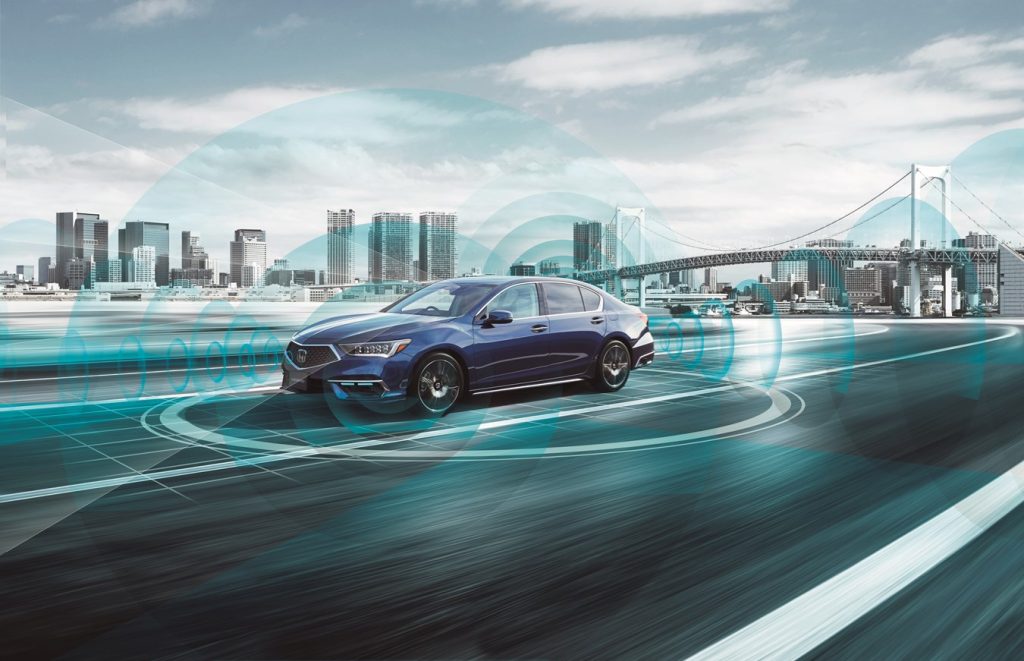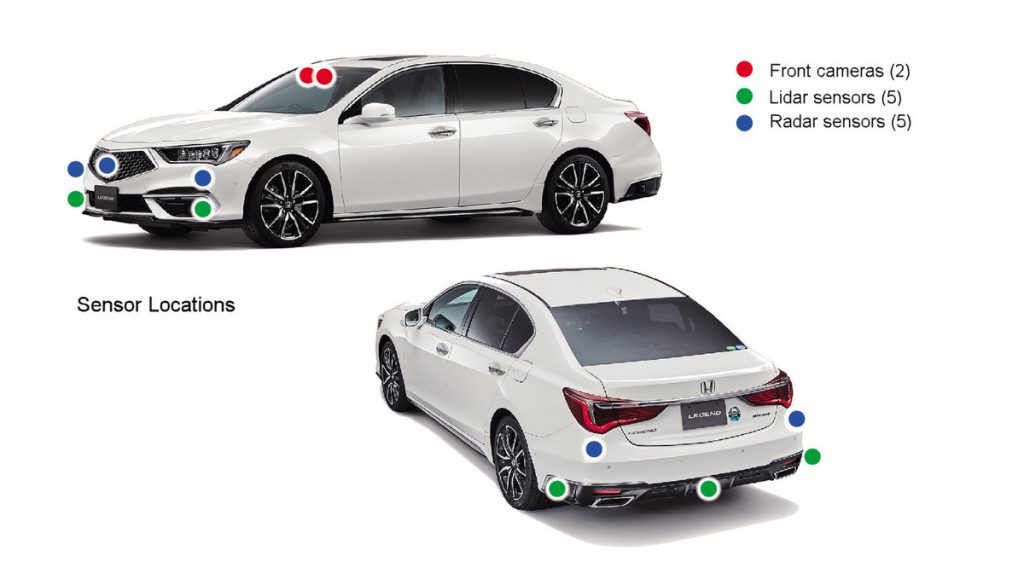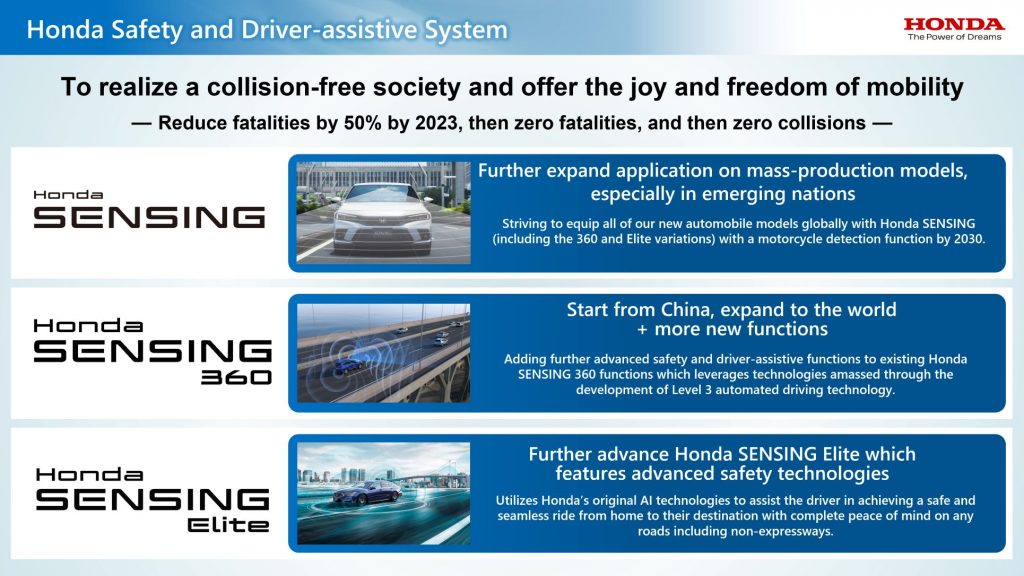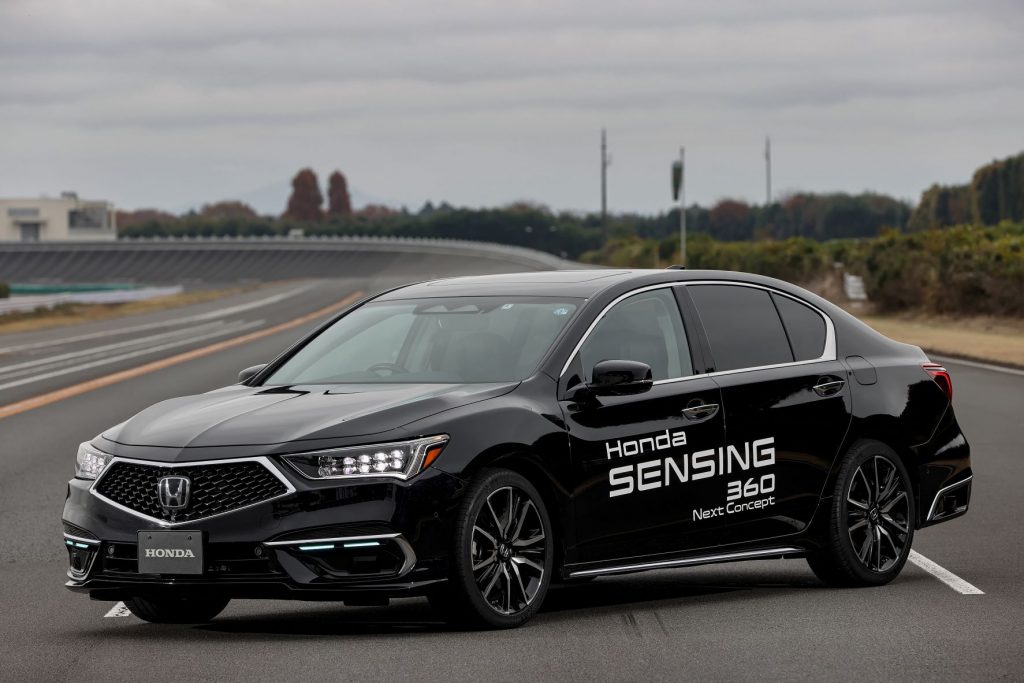
Honda Motor Co., Ltd. today announced plans to expand the capabilities of its Sensing 360 and Sensing Elite advanced driver-assistance systems. The improved Sensing 360 system will begin rolling out in the second half of the decade and will be standard on all new Honda and Acura models in the U.S. by 2030. The Acura version will be named AcuraWatch.
Since the U.S. introductions in 2014 of Honda Sensing in the 2015 Honda CR-V, and AcuraWatch in the 2015 Acura TLX, the application of these advanced driver-assistive systems has expanded throughout the Honda and Acura lineups, with nearly 7 million vehicles on U.S. roads benefitting from the technologies.

The latest safety advances reflect a global vision announced by Honda’s global CEO Toshihiro Mibe in April 2021 to strive for both zero traffic collision fatalities involving Honda motorcycles and automobiles globally by 2050 and carbon neutrality for its products and corporate activities by 2050. Honda is striving to equip all its new automobiles globally with Honda Sensing (including the 360 and Elite variations) with a motorcycle detection function by 2030 as it aims to reduce global traffic collision fatalities by half by 2030 and to zero by 2050 involving Honda motorcycles and automobiles globally.
Currently available on certain models sold in China, the first generation of Sensing 360 with an expanded sensory range around the vehicle is aimed at mitigating blind spots to enhance collision avoidance while also reducing driver burden. Starting in China in 2024, the next generation of the system will feature new technologies to further reduce driver burden by reducing the likelihood of collisions through accurate detection of abnormal conditions occurring to the driver and the vehicle’s surroundings.

Honda Sensing 360 updates
New Sensing 360 features go beyond the current suite that includes the collision mitigation braking system, front cross-traffic warning, active lane change assist, and lane change collision mitigation.
Two are related to “hands-off” functionality. The Advanced In Lane Driving with Hands-off Function reduces driver burden by operating the accelerator, brake pedal, and steering wheel to assist the driver in maintaining vehicle speed and lane keeping. When the driver switches on the Advanced Lane Change with Hands-off Function, the system assesses the situation and assists the lane change and/or passing of the other vehicle under certain conditions. When the system detects a car in front being driven at low speed, it notifies the driver and then assists in passing and returning to the original lane.

Two other key features are Driver Emergency Support System and Exit Warning.
When the driver is initially unresponsive to the system’s requests for a handover, the Driver Emergency Support System escalates alarm sounds to urge the driver to respond. If the driver remains unresponsive, the system assists in the vehicle decelerating and stopping while using hazard lights and the horn to keep the driver, occupants, and other road users away from the risk of a traffic collision.
While the vehicle is parked and the Exit Warning system detects a vehicle approaching from the rear, the indicator on the front pillar or side mirror lights up to assist occupants to recognize an approaching vehicle. When the system detects the risk of a collision between the vehicle door being opened to get out of the car and other vehicles passing by, an indicator flashes and an audible alarm to alert the occupants.

The New Sensing 360 has the technology to detect the driver’s condition and risk factors to assist frontal collision avoidance.
The Driver Attention Warning and Collision Warning System detects the driver’s condition. When there is a risk of a collision with a pedestrian, bicycle, or vehicle due to diminishing driver attention, the system reduces the vehicle speed, alerts the driver, and assists the steering to keep the vehicle inside the lane.
If there is the risk of a collision with a pedestrian, bicycle, or vehicle, and the In-Lane Collision Avoidance Assist Technology system determines that there is enough space within the lane traveled by the vehicle to avoid a collision, the system continues reducing the vehicle speed within the lane and assists the driver’s effort to avoid the collision.
To reduce the risk of a collision with a pedestrian, bicycle, or vehicle for an ill-advised steering operation, the Emergency Steering Support Technology system continues reducing the vehicle speed and assists the driver with steering.
Next-generation technologies for Sensing Elite
Honda Sensing Elite with the Traffic Jam Pilot function, which qualifies for Level 3 automated driving technology, was launched in 2021 in Japan when the company began lease sales of a Legend Hybrid EX, which it says is the first SAE Level 3 automated technology to be recognized by Japanese authorities.
The system determines vehicle position and road conditions using data from high-definition maps and the GNSS (global navigation satellite system) module, detecting the vehicle’s 360-degree surroundings using several external sensors. It also tracks the driver’s “condition” using a monitoring camera inside the vehicle. Based on a range of information, the main ECU makes proper recognitions, predictions, and decisions and applies a high-level control to acceleration, braking, and steering inputs to assist in achieving high-quality and smooth driving.
Honda engineers leaned heavily on simulations to prioritize system safety and reliability. The company says that a total of about 10 million patterns of possible real-world situations were simulated, and several demonstration tests were conducted while driving test vehicles on expressways for a total of about 1.3 million km (800,000 mi). The system incorporates many redundancies to ensure safety and reliability if problems arise.

In addition to existing lane keeping, lane changing, and Traffic Jam Pilot functions, Sensing Elite now features a driver-assistive function for merging onto and exiting an expressway.
Honda will accelerate the advancement of future Sensing Elite iterations, the flagship variation featuring more advanced safety technologies aimed at assistance for drivers on any roads including non-expressways. The company’s home-grown AI has enabled the increases in capabilities to recognize complex scenes and handle driving situations that occur in complex environments.
This includes a hands-off function while driving through a traffic jam on arterial roads, enables hands-off functions during merging onto and exiting from an expressway at a road junction, and assists the driver by automatically parking in and driving out of a home garage.
Honda will realize driver assistance on non-expressway roads by using sophisticated recognition and control technologies that can handle a complex traffic environment. The company will aim to introduce technologies to prevent collisions based on risk prediction as well as Adaptive Cruise Control and Lane Keeping Assist Systems for non-expressway roads to reduce driver burden, and the hands-off function while driving in a traffic jam on arterial roads.
Sensing Elite now offers a function to automatically park in and drive out of the garage of a single-family home or pre-assigned parking spot in a residential garage complex. Future versions will include an “automated valet parking” function, which will enable the customers to hail or get off their vehicle anywhere they go, in addition to their home.
Specific launch plans for the next generation of Honda Sensing Elite have not yet been announced, but Honda will begin applying these technologies sequentially starting in the mid-2020s.

